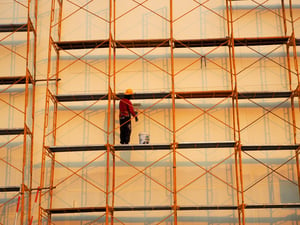
Are you ready for the Walking/Working Surfaces final rule updates? Do you know what it means for fall protection regulations in general industry? If not, now’s the time to gear up and review the regulations that protect workers from falling from heights and same level.
Early 2017, OSHA made some updates to the already technical and complicated fall protection standard CFR 1910 Subpart D. OSHA estimates that about 6.9 million general industry establishments and 112.3 million workers will be affected by these updates with the potential to prevent 29 fatalities every year. The rule doesn’t change construction or agricultural standards, but helps to improve consistency and flexibility in general industry. And if you are in the window washing biz, this could be a game changer.
We all know that fall hazards are the leading cause of death and injuries in the workplace, but for some reason fall protection always ends up on OSHA’s naughty list. From slips and trips to falling off a work platform; it’s about time general industries were able to benefit from advances in technology and be able to choose the fall protection that will best protect the worker. Maybe this will make the difference.
Here’s some of the biggest changes in Walking Working Surfaces:
- Rope Descent Systems (RDS): With the rule in place, now employers can use RDS up to 300 feet above a lower level, employ personal fall arrest systems (PFAS) and can require worker training on personal fall protection systems and other equipment designed for fall protection
- Ladders: Ladders must be able to support the maximum intended load and ladder stands and platforms be able to support 4 times the max intended load. Ladders must be inspected before each use
- Existing Fixed Ladders: For those over 24 feet and those for outdoor advertising must be equipped with a cage, well, PFAS or ladder system (within 2 years)
- Fixed Ladders: Fixed ladder more than 24 feet, the rule phases in ladder safety systems and personal fall arrest systems and phases out cages or wells (within 20 years)
- Portable Ladders: Must not be moved, shifted or extended with a worker on and cannot be used on slippery surfaces unless secured and stabilized with slip resistant rungs
- Stairway: Workers who may be exposed to unprotected side or edges with 4 feet or more fall potential must be protected by guardrails or stair rail system
- Dockboards: Worker must be protected by a guardrail or handrails if working on a dockboard that has a fall potential of 4 feet or more. Workers should not be exposed to fall heights of 10 feet or more
- Scaffolding: Worker must be protected in accordance with 29 CFR 1926 subpart L and must be protected with a PFAS at height of 4 feet or more
- Training: Workers must be trained on fall hazards and fall protection equipment (within 6 months)
- Inspection: Inspect and certify permanent anchorage for RDS (within 1 year)
While there may be new rules to follow, general industry now has more flexibility in choosing fall protection systems that will actually work for the application
Now, employers can select the fall protection system that works for the job. Instead of having to rely only on a guardrail system, employers can choose from personal fall arrest systems, ladder safety systems, travel restraints and work positioning systems. The construction industry allowed these measures since 1994 and finally general industry isn’t bound by practices that often failed.
Here’s some other examples of equipment that you now have the option of using on the jobsite:
- Halo Cable Self-Retracting Lifelines: SRL designed specifically for leading edge (LE) work. Includes integrated shock absorbing component that helps refocus forces away from the portion of the cable that comes into contact with the edge. Features galvanized steel cable and steel snap hook connector
- TurboLite™ MAX: Spectra® webbing lifeline with a variety of connector options. Designed for use in smooth edge applications with radius = 0.060" (1.5 mm). Can be used for foot-level tie-off or anchored overhead for workers up to 420 lbs. Integral swivel design prevents lifeline from twisting and enables more natural movement of the worker
- TurboLite™ T-BAK™ EXTREME: Galvanized cable lifeline with Vectran™ web tie-back and 5K® steel locking tie-back hook. Designed for use in sharp edge applications with radius = 0.005" (0.13 mm). Includes integral shock absorber to reduce force on the worker if a fall were to occur over an edge. Can be used for foot-level tie-off or anchored overhead for workers up to 420 lbs.
- Nano-Lok™Edge Self-Retracting Lifeline: Specifically designed for foot level tie-off, when anchoring at the user’s feet is the only option. Ergonomically designed for comfort. Limits average arresting forces to 900 lbs. or less. Requires fall clearances as low as 16’
- Daytona Big Block Self-Retracting Lifeline: Available in both 50' and 65' models, as well as with a variety of connector component options. ABS housing is reinforced with an inner brace for durability, and all critical parts are machined and void of any plastic components
Any time standards change or are updated it can be a real hassle, but this one may actually make things a little more consistent across industries. Many employers perform jobs that cross construction/general industry boundaries anyway, making the requirements consistent across the board and offering solutions (that actually work) may be worth the time you will spend learning this new update.
Identifying slip, trip and fall hazards on a job site and providing either maintenance or equipment to reduce or eliminate the risks only helps you and your workers. Make sure you are compliant. You may want to be on a Top 10 list for being the best, just make sure it isn’t for violations.
Safety: It's Your Life, It's Our Business








